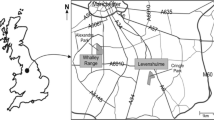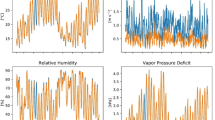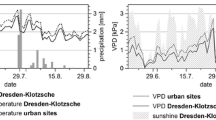Abstract
An important ecosystem service provided by urban trees is the cooling effect caused by their transpiration. The aim of this study was to quantify the magnitude of daytime and night-time transpiration of common urban tree species in a high latitude city (Gothenburg, Sweden), to analyse the influence of weather conditions and surface permeability on the tree transpiration, and to find out whether tree transpiration contributed to daytime or nocturnal cooling. Stomatal conductance and leaf transpiration at day and night were measured on mature street and park trees of seven common tree species in Gothenburg: Tilia europaea, Quercus robur, Betula pendula, Acer platanoides, Aesculus hippocastanum, Fagus sylvatica and Prunus serrulata. Transpiration increased with vapour pressure deficit and photosynthetically active radiation. Midday rates of sunlit leaves ranged from less than 1 mmol m−2 s−1 (B. pendula) to over 3 mmol m−2 s−1 (Q. robur). Daytime stomatal conductance was positively related to the fraction of permeable surfaces within the vertically projected crown area. A simple estimate of available rainwater, comprising of precipitation sum and fractional surface permeability within the crown area, was found to explain 68 % of variation in midday stomatal conductance. Night-time transpiration was observed in all studied species and amounted to 7 and 20 % of midday transpiration of sunlit and shaded leaves, respectively. With an estimated night-time latent heat flux of 24 W m−2, tree transpiration significantly increased the cooling rate around and shortly after sunset, but not later in the night. Despite a strong midday latent heat flux of 206 W m−2, a cooling effect of tree transpiration was not observed during the day.








Similar content being viewed by others
References
Aasamaa K, Sõber A (2001) Hydraulic conductance and stomatal sensitivity to changes of leaf water status in six deciduous tree species. Biol Plant 44:65–73
Aasamaa K, Sõber A, Hartung W, Niinemets Ü (2002) Rate of stomatal opening, shoot hydraulic conductance and photosynthetic characteristics in relation to leaf abscisic acid concentration in six temperate deciduous trees. Tree Physiol 22:267–276
Bartens J, Day SD, Harris JR, Wynn TM, Dove JE (2009) Transpiration and root development of urban trees in structural soil stormwater reservoirs. Environ Manag 44:646–657
Bowler DE, Buyung-Ali L, Knight TM, Pullin AS (2010) Urban greening to cool towns and cities: a systematic review of the empirical evidence. Landsc Urban Plan 97:147–155. doi:10.1016/j.landurbplan.2010.05.006
Bühler O, Nielsen CN, Kristoffersen P (2006) Growth and phenology of established Tilia cordata street trees in response to different irrigation regimes. Arboricult Urban For 32:3–9
Caird MA, Richards JH, Donovan LA (2007) Nighttime stomatal conductance and transpiration in C3 and C4 plants. Plant Physiol 143:4–10
Celestian SB, Martin CA (2005) Effects of parking lot location on size and physiology of four southwestern US landscape trees. J Arboric 31(4):191–197
Chapin FS III, Chapin MC, Matson PA, Vitousek P (2011) Principles of terrestrial ecosystem ecology. Springer, New York
Chen JM, Blanken PD, Black TA, Guilbeault M, Chen S (1997) Radiation regime and canopy architecture in a boreal aspen forest. Agric For Meteorol 86(1):107–125
Chen L, Zhang Z, Li Z, Tang J, Caldwell P, Zhang W (2011) Biophysical control of whole tree transpiration under an urban environment in Northern China. J Hydrol 402:388–400
Clark JR, Kjelgren R (1990) Water as a limiting factor in the development of urban trees. J Arboric 16:203–208
Close R, Nguyen P, Kielbaso J (1996) Urban vs. natural sugar maple growth: I. Stress symptoms and phenology in relation to site characteristics. J Arboric 22:144–150
Cregg BM (1995) Plant moisture stress of green ash trees in contrasting urban sites. J Arboric 21:271–276
Daley MJ, Phillips NG (2006) Interspecific variation in nighttime transpiration and stomatal conductance in a mixed New England deciduous forest. Tree Physiol 26:411–419
Eliasson I, Holmer B (1990) Urban heat island circulation in Göteborg, Sweden. Theor Appl Climatol 42:187–196
Ferrini F, Baietto M (2007) Effect of compost-amended backfill and paved surface on leaf parameters and physiology of Norway maple (Acer platanoides L.). Arboricult Urban For 33:386–391
Fisher JB, Baldocchi DD, Misson L, Dawson TE, Goldstein AH (2007) What the towers don’t see at night: nocturnal sap flow in trees and shrubs at two AmeriFlux sites in California. Tree Physiol 27:597–610
Hagishima A, Ki N, Tanimoto J (2007) Field experiment on transpiration from isolated urban plants. Hydrol Process 21:1217–1222
Hamada S, Ohta T (2010) Seasonal variations in the cooling effect of urban green areas on surrounding urban areas. Urban For Urban Green 9:15–24
Holmer B, Thorsson S, Eliasson I (2007) Cooling rates, sky view factors and the development of intra-urban air temperature differences. Geogr Ann Ser A Phys Geogr 89A:237–248
Holmer B, Thorsson S, Lindén J (2013) Evening evapotranspirative cooling in relation to vegetation and urban geometry in the city of Ouagadougou, Burkina Faso. Int J Climatol 33:3089–3105
Kjelgren R, Clark JR (1992) Microclimates and tree growth in three urban spaces. J Environ Hortic 10:139
Kjelgren R, Montague T (1998) Urban tree transpiration over turf and asphalt surfaces. Atmos Environ 32:35–41
Konarska J, Lindberg F, Larsson A, Thorsson S, Holmer B (2014) Transmissivity of solar radiation through crowns of single urban trees—application for outdoor thermal comfort modelling. Theor Appl Climatol 117:363–376
Leuzinger S, Vogt R, Körner C (2010) Tree surface temperature in an urban environment. Agric For Meteorol 150:56–62
LI-COR (2009) LAI-2200 Plant Canopy Analyzer Instruction Manual. ftp://ftp.licor.com/perm/env/LAI-2200/Manual/LAI-2200_Manual.pdf. Accessed 16 June 2014
Lindén J (2011) Nocturnal cool island in the Sahelian City of Ouagadougou, Burkina Faso. Int J Climatol 31:605–620
Mayer H, Kuppe S, Holst J, Imbery F, Matzarakis A (2009) Human thermal comfort below the canopy of street trees on a typical Central European summer day. Ber Meteor Inst Univ Freiburg 18:211–219
Mueller EC, Day TA (2005) The effect of urban ground cover on microclimate, growth and leaf gas exchange of oleander in Phoenix, Arizona. Int J Biometeorol 49:244–255
Nielsen CN, Bühler O, Kristoffersen P (2007) Soil water dynamics and growth of street and park trees. Arboricult Urban For 33:231–245
Oke TR (1987) Boundary layer climates. 2nd edn. Methuen, London
Pataki DE, McCarthy HR, Litvak E, Pincetl S (2011) Transpiration of urban forests in the Los Angeles metropolitan area. Ecol Appl 21:661–677
Peters EB, McFadden JP, Montgomery RA (2010) Biological and environmental controls on tree transpiration in a suburban landscape. J Geophys Res B (2005–2012) 115. doi: 10.1029/2009JG001266
Phillips N, Ryan M, Bond B, McDowell N, Hinckley T, Čermák J (2003) Reliance on stored water increases with tree size in three species in the Pacific Northwest. Tree Physiol 23:237–245
Rahman M, Smith J, Stringer P, Ennos A (2011) Effect of rooting conditions on the growth and cooling ability of Pyrus calleryana. Urban For Urban Green 10:185–192
Roberts BR (1977) The response of urban trees to abiotic stress [moisture, temperature, light, pesticides]. J Arboric 3(4):75–78
Rocklöv J, Ebi K, Forsberg B (2011) Mortality related to temperature and persistent extreme temperatures: a study of cause-specific and age-stratified mortality. Occup Environ Med 68:531–536
Sæbø A, Benedikz T, Randrup TB (2003) Selection of trees for urban forestry in the Nordic countries. Urban For Urban Green 2:101–114
Shashua-Bar L, Pearlmutter D, Erell E (2011) The influence of trees and grass on outdoor thermal comfort in a hot-arid environment. Int J Climatol 31:1498–1506. doi:10.1002/Joc.2177
Sieghardt M, Mursch-Radlgruber E, Paoletti E et al. (2005) The abiotic urban environment: impact of urban growing conditions on urban vegetation. In: Nilsson K, Randrup T, Schipperijn J, Konijnendijk C (eds) Urban forests and trees. Springer, Berlin Heidelberg, pp 281–323. doi:10.1007/3-540-27684-X_12
SMHI (2013) The Swedish Meteorological and Hydrological Institute. http://www.smhi.se/klimatdata. Accessed 1 Nov 2013
Snyder K, Richards J, Donovan L (2003) Night‐time conductance in C3 and C4 species: do plants lose water at night? J Exp Bot 54:861–865
Upmanis H, Eliasson I, Lindqvist S (1998) The influence of green areas on nocturnal temperatures in a high latitude city (Goteborg, Sweden). Int J Climatol 18:681–700
Wang H, Ouyang Z, Chen W, Wang X, Zheng H, Ren Y (2011) Water, heat, and airborne pollutants effects on transpiration of urban trees. Environ Pollut 159:2127–2137
Wang H, Wang X, Zhao P, Zheng H, Ren Y, Gao F, Ouyang Z (2012) Transpiration rates of urban trees, Aesculus chinensis. J Environ Sci 24:1278–1287
Whitlow TH, Bassuk NL (1988) Ecophysiology of urban trees and their management: the North American experience. Hortscience 23:542–546
Whitlow TH, Bassuk NL, Reichert DL (1992) A 3-year study of water relations of urban street trees. J Appl Ecol 29:436–450
Acknowledgments
The project was funded by the Swedish Research Council Formas (259-2012-887 and 214-2010-1706), Swedish Transport Administration and Mistra Urban Futures. Special thanks are due to Malin Löfstrand and Elise Nässén for permission to conduct measurements in Trädgårdsföreningen and Stampen Parks, respectively, as well as to Thomas Berg Hasper and Ignacio Ruíz Martinez for help with the measurements.
Author information
Authors and Affiliations
Corresponding author
Rights and permissions
About this article
Cite this article
Konarska, J., Uddling, J., Holmer, B. et al. Transpiration of urban trees and its cooling effect in a high latitude city. Int J Biometeorol 60, 159–172 (2016). https://doi.org/10.1007/s00484-015-1014-x
Received:
Revised:
Accepted:
Published:
Issue Date:
DOI: https://doi.org/10.1007/s00484-015-1014-x




